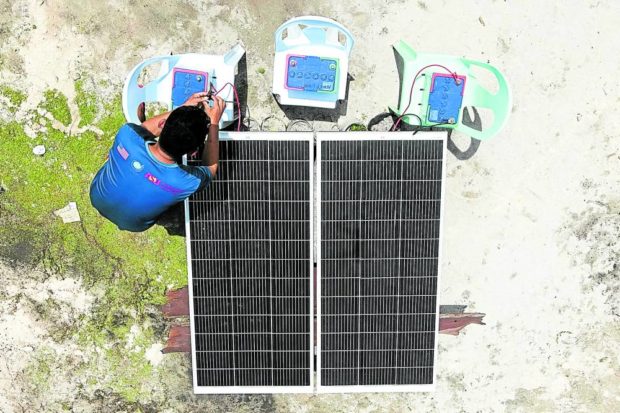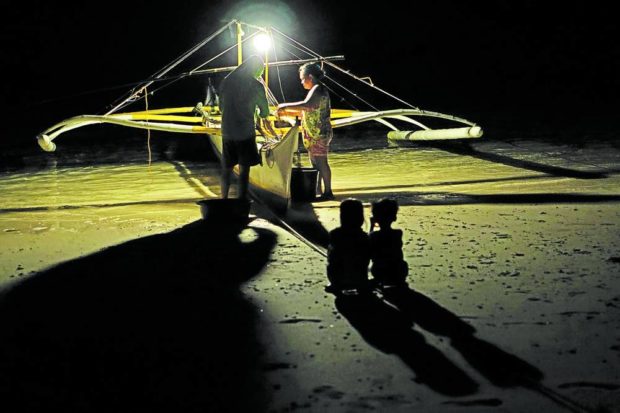Solar power fuels Surigao island’s rise from Odette

POWERED BY THE SUN | A teacher prepares the batteries to be attached to the solar panels that power television sets use for classroom lessons at Halian Elementary School on a remote island in Del Carmen, Surigao del Norte. (Photo by ERWIN M. MASCARIÑAS / Inquirer Mindanao)
DEL CARMEN, Surigao del Norte, Philippines — Fisherman Bernabe Batican, 62, remembers salvaging a solar panel from among a pile of debris that included his wrecked fishing boat near their house in the island village of Halian.
The panel flew off from their roof amid strong winds as Supertyphoon Odette (international name: Rai) barreled through the island last year, destroying almost everything that lie on its path.
“We fixed and rewired it, and luckily, it worked again so the night was a bit bearable because we have light,” Batican said.
In 2011, Batican and several other fishers in off-grid Halian received the solar lighting aid from a charitable group in partnership with the Del Carmen municipal government, enabling him to charge six lamps that he uses when going on a fishing trip.
In the aftermath of Odette’s fury, posts carrying electricity wires from a diesel-powered generator connected to households toppled, plunging into darkness the island which is situated between the main islands of Dinagat and Siargao, and on fair weather, is an hour away by boat from Del Carmen.
Article continues after this advertisementAccording to village chief Elsa Tampos, only a few families have solar lighting prior to Odette as most of them relied on the diesel-powered generator.
Article continues after this advertisementShe recalled that the first few nights after the devastating storm felt like a nightmare. But the 287 families living on the island stayed together, and the solar-powered lights gave them hope of eventually rising from the tragedy.
It was a blessing that nongovernmental organizations (NGOs) who brought aid to the island donated solar panels and lamps as part of their relief and recovery packages a few weeks after Odette, Tampos said.
From Dec. 16, 2021, when Odette struck, until April this year, Halian residents were solely dependent on solar energy as it took some time to fully repair the electricity posts on the island.
Seeing good results from solar harvesting, many households saved money to invest in panels with larger capacity to power not only their lamps but other gadgets such as electric fans, cellphone and radio sets.
The island’s early recovery was also fueled by the installation of solar street lights donated by NGOs, Tampos said.
In time for the reopening of in-person classes last August, the Young Southeast Asian Leaders Initiative donated three large solar panels and six batteries that can power several televisions for delivering lessons.
Alma Sulima Petallo-Litang, principal of Halian Elementary School, said small solar lamps were also useful for kids as these gave them ample time to study their lessons at night.

NIGHT LIGHT | A fisherman and his wife use a solar lamp as they sort out their catch one early morning on the shore of Halian in Del Carmen, Surigao del Norte. (Photo by ERWIN M. MASCARIÑAS / Inquirer Mindanao)
Shift
These recent experiences of islanders had drawn them to the idea of shifting to solar energy to power their homes and fishing activities.
“After Odette, we realized that solar panels are really useful. If typhoons will come, we can just remove these from our roof and keep these safe,” Tampos said.
“Also, it is not expensive to use since it only requires light from the sun, unlike the diesel-powered generator which needs expensive fuel,” Tampos added.
The village, Tampos said, is consuming four gallons of diesel every night, costing them up to P1,500.
“Prior to the pandemic and Odette, we turned on the generator for four hours, from 6 p.m. to 10 p.m. But now, with the soaring [fuel] prices, we had to reduce usage to just two hours and 30 minutes,” she said.
To avail of this electricity service, each household had to shell out P5 for every lamp used in their homes. The barangay council had to subsidize the cost as most families can only afford that amount.
If the same level of service is made round the clock, it means that every household in Halian had to pay P80 each day or P2,400 every month.
“I hope that in the future, larger solar panels will be installed here, so that we will no longer use the diesel-powered generator and Halian will have 24-hour supply of electricity,” said resident Nera Dullo, 48, who realized the importance of solar energy in the aftermath of Odette.
Assistance
Dullo said she was hoping that financial or technical help could be secured so the village could install its own solar-powered energy system.
This aspiration, however, is beginning to be realized.
In February 2022, Ayala Foundation together with Rare Philippines, Lokal Lab, and Siargao Environmental Awareness Movement, initiated a relief mission in Halian that donated solar lighting equipment apart from materials for boat repair.
The Department of Education (DepEd) has also announced that it is installing solar power systems in “last mile” schools on Siargao Island. These are schools with less than four classrooms, usually makeshift and nonstandard ones; no electricity; no funds for repairs or new construction projects in the last four years; and has a travel distance of more than an hour away from the town or village center, accessible only through difficult terrain.
The DepEd said each solar power system installed in Pacifico Elementary School in San Isidro town, Katipunan Elementary School in Pilar town, and Bailan Elementary School in Sta. Monica town has a 30 kilovolt-ampere capacity.
Other islands in Siargao are also installing solar panels as part of the recovery strategy.
The Junior Chamber International has donated solar lights to over 8,000 families in the towns of Pilar, General Luna, Burgos, San Isidro, and Sta. Monica.
The World Wide Fund for Nature-Philippines initiated a solar energy project in some remote small islands in Siargao, including Anajawan and Halian in 2019 but was derailed by the pandemic and then Odette.
The Solar Community-Based Island Tourism and Livelihood Energizer Platform, which is funded by the European Union, aims to provide adequate 24/7 renewable energy services to support sustainable ecotourism as well as start livelihood opportunities in four island communities on Siargao and Dinagat islands. It is set to be completed by year-end, said project manager Joeffrey Maglinte.
Anajawan village chief Rosebelt Lim said the project would be life-changing for islanders who had yet to experience a continuous power supply in their households.
“It’s hard and costly for us to preserve our harvested fish since we need to go to the mainland to buy ice blocks. But with the solar power system, we will no longer need to travel as we can produce our own ice once we have a refrigerator, thus reducing our operational costs,” he said.
Best strategy
Dinagat, which was also devastated by the typhoon, received several solar power systems from organizations helping the residents in disaster recovery.
In Barangay Coring in Basilisa, Greenpeace Philippines installed solar panels in the village gymnasium that can deliver 4,800 watts of electricity to the community. SolarSolutions, on the other hand, installed 40-watt solar panels on Columbus Island and in Barangay Imee.
Arturo Tahup, associate for community resilience of the Institute for Climate and Sustainable Cities, said that relying on four- to six-hour daily electricity powered by diesel generators was not enough to meet the energy needs of homes, community facilities, social services and people’s livelihoods in isolated, off-grid islands like Halian.
“The best strategy for achieving 24/7 electrification and powering sustainable development in Halian and other small islands in the country is setting up hybrid microgrids or combining renewable energy technology such as solar, wind, biomass and even tidal ocean, with the existing diesel plants on these islands,” said Tahup.
Studies have found that renewable energy-based hybrid systems could be a suitable alternative to diesel power plants in island grids. A study by Joey Ocon and Paul Bertheau of the Department of Chemical Engineering of the University of the Philippines Diliman found that a shift from diesel generation to solar photovoltaics-battery-diesel hybrid systems, could reduce power cost by as much as 20 percent.
“By encouraging private sector participation, hybridization could help provide electrification for 24 hours, stabilize the true cost of generation rate with less dependence on imported diesel prices, and reduce greenhouse gas emissions,” the study revealed.
Del Carmen Mayor Alfredo Coro II said the Halian experience had encouraged the local government to tap renewable energy for the town’s needs.
“What we want to do is to craft a policy on the incentives that we are going to give to our people so they will be encouraged to adopt such innovations whether in their households or businesses,” Coro said.
* * *
Editor’s Note: Reporting for this story was supported by the Institute for Climate and Sustainable Cities under the Jaime Espina Klima Correspondents Fellowship.